Splenius cervicis muscle
| Splenius cervicis muscle | |
|---|---|
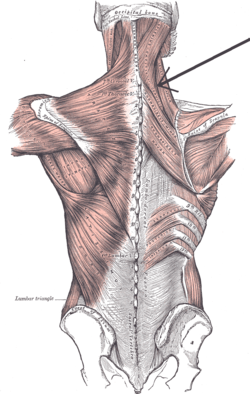 Muscles connecting the upper extremity to the vertebral column. (Splenius capitis et cervicis labeled at upper right, at neck.) | |
| Details | |
| Latin | Musculus splenius cervicis |
| Spinous processes of T3-T6 | |
| Transverse processes of C1-C3 | |
| Transverse cervical artery and occipital artery | |
| Posterior rami of the lower Cervical spinal nerves | |
| Actions | Bilaterally: Extend the head & neck, Unilaterally: Lateral flexion to the same side, Rotation to the same side. |
| Identifiers | |
| Gray's | p.397 |
| Dorlands /Elsevier | m_22/12550921 |
| TA | A04.3.02.104 |
| FMA | 22681 |
| Anatomical terms of muscle | |
The splenius cervicis (/ˈspliːni.əs sərˈvaɪsɨs/) (also known as the splenius colli, /ˈspliːni.əs ˈkɒlaɪ/) is a muscle in the back of the neck. It arises by a narrow tendinous band from the spinous processes of the third to the sixth thoracic vertebrae; it is inserted, by tendinous fasciculi, into the posterior tubercles of the transverse processes of the upper two or three cervical vertebrae.
Its name is based on the Greek word σπληνίον, splenion (meaning a bandage) and the Latin word cervix (meaning a neck).[1] The word collum also refers to the neck in Latin.[1]
The function of the splenius cervicis muscle is extension of the cervical spine, rotation to the ipsilateral side and lateral flexion to the ipsilateral side.[2]
Additional images
-
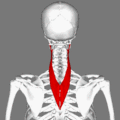
Position of splenius cervicis muscle (shown in red).
-
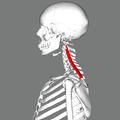
Lateral view.
-
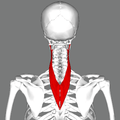
Posterior view.
-
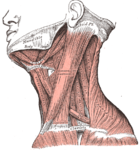
Muscles of the neck. Lateral view.
-

Section of the neck at the level of the sixth cervical vertebra.
References
This article incorporates text in the public domain from the 20th edition of Gray's Anatomy (1918)
- ↑ 1.0 1.1 Dr. M. A. (Toby) Arnold; Deborah Bryce. "Arnold's Glossary of Anatomy". The University of Sydney.
- ↑ R.T. Floyd, Manual of Structural Kinesiology, 2012, 18th Ed.
External links
| Wikimedia Commons has media related to Splenius cervicis muscles. |
| ||||||||||||||||||||||||||||||||||||||||||||||||||||||||